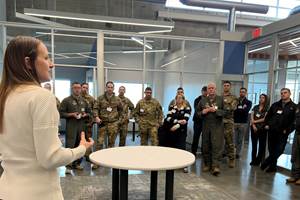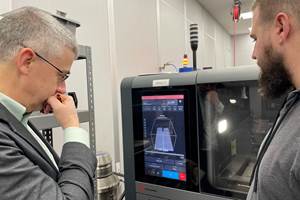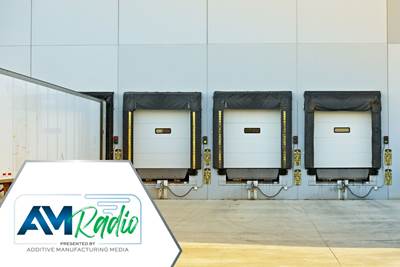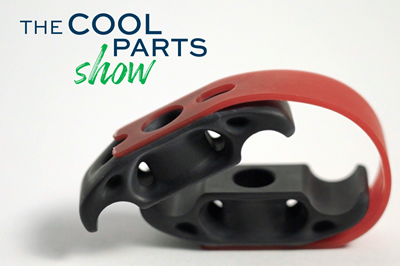7 Takeaways From America Makes MMX 2023
America Makes just held its recent Members Meeting & Exchange. Here are observations related to cost and collaboration; digital manufacturing; and the sustainment and supply chain needs of the DoD.
America Makes just held its annual Members Meeting & Exchange (MMX) event in Youngstown, Ohio. America Makes is the U.S. Department of Defense’s national manufacturing innovation institute for additive manufacturing. MMX is a yearly conference with speakers covering the status of America Makes efforts and the outlook for DoD needs as they relate to AM. It is also a networking opportunity for connecting the institute’s members across commercial industry as well as academia, government and economic development organizations.
Here are several points that struck me as interesting or important throughout the course of the two-day event:
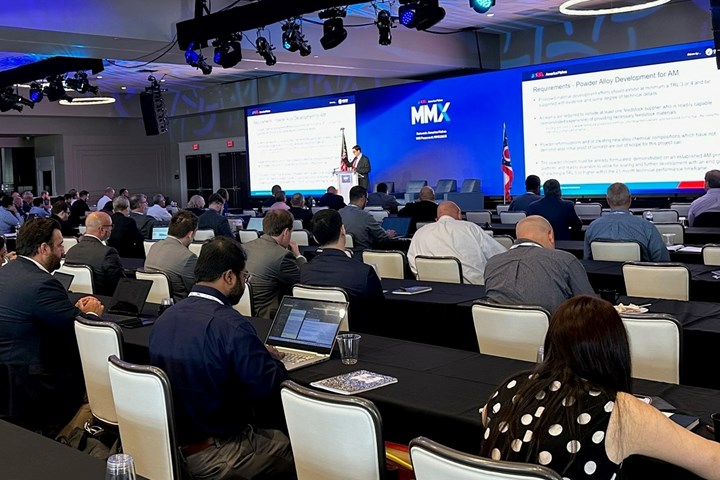
America Makes' Brandon Ribic announced project calls involving high-temp materials and material datasets.
1. America Makes project calls generally favor ideas that are already on a shelf.
The institute’s technology director Brandon Ribic made this point in describing two project calls announced during MMX, involving high-temp materials and material datasets. America Makes project calls are funding opportunities for AM-related technology development the DoD has identified as valuable. Calls such as these are defined and specific, but they are also broad enough in their proposed scope to cover various possibilities. The opportunities inherently target the kinds of ideas that have already been seen and somewhat explored, just not carried all the way due to lack of funding.
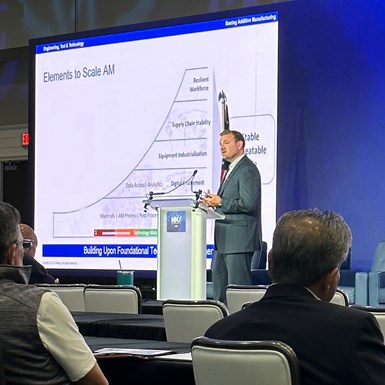
Nick Mulé, director of Additive Manufacturing with Boeing, spoke of the increasing recognition of the interconnectedness between design, fabrication and postprocessing necessary to realize the promise of additive manufacturing, and to focus on solving the problems needed to advance it.
2. Collaboration is a consequence of cost sharing.
Ben DiMarco of The Ohio State University additive manufacturing lab noted this point during a panel discussion on the subject of teaming for project calls. The cost sharing requirements of America Makes project calls can be demanding. For example, a 25% cost share means the recipient of the award must contribute 25 cents for every dollar awarded. In calls for which he has submitted proposals, he says he has recruited a number of companies for the sake of spreading the cost share burden. This amplifies the need for effective organization and leadership among the project partners, part of what he discussed on the panel. Industry collaboration is thus a not-unfortunate consequence of the cost share requirement.
3. “Contested logistics” will be a factor in future warfare.
The military’s pursuit of additive manufacturing as a deployable capability is about more than faster repair of hardware in the field or at sea. There is also the recognition that in any future war, shipping materiel to the theater of conflict is liable to be an activity under attack, by means including cyber. Manufacturing in a forward location helps answer this. Jordan Gillis, specialist executive for government and public services with Deloitte, cited this as part of a talk about the current state of the defense industrial base; another point he raised follows.
4. Additive manufacturing is an answer for vendor lock.
“Vendor lock,” another term Gillis cited, is also a factor the military is trying to overcome. Military systems are being designed and specified to recognize they are likely to remain in use longer than anticipated (like the 70-year-old B52 bomber), and longer than many component vendors will remain accessible. This much was not stated, but instead where my thoughts went: Additive manufacturing is directly relevant because “vendor lock” is to a large extent related to tooling; it becomes a problem when it means tooling created by a vendor is no longer attainable. Going toolingless is not a complete answer, but part of the response.
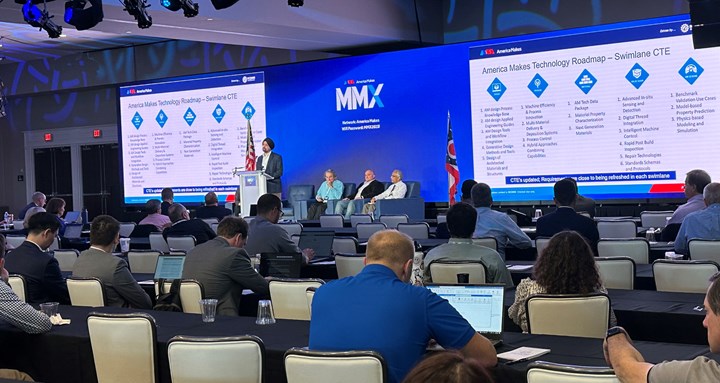
Prabhjot Singh, director of the Additive Manufacturing Process & Capability Center with Raytheon, led an update of the Technology Roadmap Advisory Group.
5. Working group involvement is the best way to make sure America Makes pursues your priorities.
A set of working groups meets to continually develop and refine a technology roadmap for the gaps and opportunities for improvement in AM that deserve to be addressed. America Makes seeks to connect the priorities of this roadmap to funded technology development projects from the government. America Makes executive director John Wilczynski stressed this point after a presentation on the roadmap: If you want to see what you consider to be important AM technology development priorities advance with America Makes’ help, then getting involved with a technology roadmap working group (as part of America Makes membership) is a good way to pursue this.
6. Additive manufacturing earns a 10% manufacturing wage premium.
The institute is also involved in developing the AM workforce. Josh Cramer, America Makes director of education and workforce development, gave an overview of these efforts, along with what the institute has learned through its surveys of the AM workforce landscape. One finding based on a broad survey of manufacturing job postings is this: On average, for core manufacturing positions, employees with AM experience are being offered 10% more in wage or salary than comparable employees who lack this experience.
7. Supply chain resiliency demands visibility.
Danielle Miller with the Office of the Assistant Secretary of Defense for Industrial Policy spoke about the DoD’s response to vulnerabilities and perceived deficiencies in the defense supply chain. COVID-19 and the invasion of Ukraine took abstract concerns about the strength of the supply chain and made them manifestly real, she said. The DoD is responding with initiatives in various areas, including strategies recognizing U.S. industrial vulnerabilities in casting and forging capacity as well as the availability of critical materials. In addition, “The DoD does not have good visibility into the supply chain,” she noted. A project underway involves collecting data from the prime and first-, second- and third-tier suppliers for over 100 weapons systems to evaluate the data needed for meaningful visibility into the capacities of suppliers and how to obtain and aggregate this information. Another case where my thoughts (and those of others in the room, I am sure) went to additive: An inherently digital mode of manufacturing lends itself to this kind of reporting and real-time visibility.
Related Content
How a DOD-Funded Resilient Manufacturing Ecosystem (RME) Is Coming Together at Neighborhood 91
Pittsburgh’s additive manufacturing campus doubles as a test bed for a Department of Defense project aimed at developing a reproducible ecosystem for on-demand production of critical parts.
Read MoreAdditive Manufacturing for Defense: Targeting Qualification
Targeting qualification in additive manufacturing for the defense industry means ensuring repeatability as well as reliability as there is much at stake, including human lives. Certain requirements therefore must be met by weapons systems used by the defense industry.
Read MoreNew Zeda Additive Manufacturing Factory in Ohio Will Serve Medical, Military and Aerospace Production
Site providing laser powder bed fusion as well as machining and other postprocessing will open in late 2023, and will employ over 100. Chief technology officer Greg Morris sees economic and personnel advantages of serving different markets from a single AM facility.
Read MoreFreeform: Binder Jetting Does Not Change the Basics of Manufacturing
Rather than adapting production methodologies to additive manufacturing, this Pennsylvania contract manufacturer adapts AM to production methodologies. In general, this starts with conversation.
Read MoreRead Next
3D Printing for Supply Chain Resiliency: AM Radio #39
Additive manufacturing can speed, strengthen and simplify industrial supply chains. How close are we to realizing this promise? Dr. Tim Simpson and Peter Zelinski discuss lead time, logistics and other factors on AM Radio.
Read MoreData: The Dark (and Light) Side of Additive Manufacturing: AM Radio #41
Additive manufacturing relies on and creates large amounts of data. On AM Radio, Stephanie Hendrixson and Dr. Tim Simpson discuss concerns around protecting AM data, plus how data security can bring greater opportunities for this technology.
Read More3D Printed Replacement Clamp for an F-16 Aircraft: The Cool Parts Show #54
3D printing is a valuable addition to sustainment programs, but only if printed parts can be qualified as fast and flexibly as they can be made. In this episode of The Cool Parts Show, we look at the clamp that won the Air Force’s Approval Sprint Challenge designed to address this need.
Read More







.png;maxWidth=300;quality=90)








